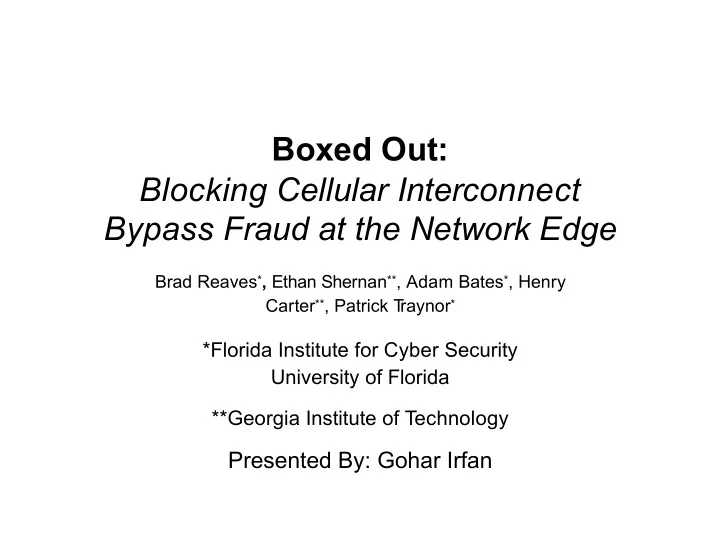

Boxed Out: Blocking Cellular Interconnect Bypass Fraud at the Network Edge Brad Reaves * , Ethan Shernan ** , Adam Bates * , Henry Carter ** , Patrick T raynor * *Florida Institute for Cyber Security University of Florida **Georgia Institute of T echnology Presented By: Gohar Irfan
Are you happy with your long distance carrier? There is a black market for long-distance and international call termination Some companies provide “gray routes” that deliver calls without paying required tariffs or using regulated interconnects between carriers How do you connect to a carrier without them knowing?
Typical Interna7onal Call
Enter: Simbox Fraud Simbox PSTN PSTN Internet VoIP GSM Network B Network A Simbox International Border Legitimate Local Call The point of this setup is to deliver a call into carrier B without paying for a real interconnection with that carrier. Carriers use the term “interconnect bypass fraud” We’ll use the term “simbox fraud” for this talk
This is a real problem Cellular networks are necessarily provisioned under an assumptions of average call volume/cell The cellular network is fundamentally incapable of supporting the load of an illicit, unlicensed telecommunications provider Not to mention: • Call quality is terrible • People near the simbox operation have trouble placing calls • It costs carriers $2 Billion annually
Cellular Networks • GSM (Global System for Mobile Communica6ons) • 2G • 3G • 4G LTE • SIM (Subscriber Iden6ty Module) • GSM Full Rate (GSM FR) for encoding
VoIP • Voice over Internet Protocol • IP Only • IP-PSTN • Carried over UDP • Characteris6cs: • Packet loss • JiOer • Gaps are filled by silence (default) • PLC (Packet Loss Concealment Algorithms)
Simbox • Connects VoIP calls to GSM network • There is a strong legi6mate market for these • Private Enterprise Telephone Networks • Support hundreds of SIM cards and codecs • “Sim Servers” – use “virtual SIM cards” for calls
Ammit • This work presents the Ammit system • Key Insight: Simboxed call audio will sound different than legitimate call audio • Ammit detects individual calls in real time at the tower servicing the simbox • Ammit can isolate individual calls and SIM cards aWer just 20 calls
Why Ammit W orks Over-the-Air Degrades PSTN PSTN Internet VoIP GSM Network B Network A Simbox International Border Legitimate Local Call Source V oIP Network Degrades Degrades
Dealing with Air Loss Cellular voice sees typical loss rates of several percent How are we supposed to tell legitimate losses from losses due to simboxing? Have the tower keep track of lost frames and ignore them when analyzing the audio!
Audio degrada7ons in VoIP Because V oIP is entirely digital, audio only degrades from lost (or really late) packets When losses occur, a V oIP client can either: 1. Insert silence 2. T ry to conceal packet losses
Detec7ng Unconcealed Losses We can compute the short-term energy of audio and look for sudden drops and rises again 0.02 Packet Loss Detected Loss 0.018 0.016 0.014 Short − time energy 0.012 0.01 0.008 True Undetectable Positive 0.006 Loss 0.004 0.002 0 0 50 100 150 200 250 Time (ms)
Detec7ng concealed losses Authors looked at the GSM-FR packet loss concealment algorithm GSM-FR conceals losses by repeating and attenuating the last good 20 millisecond frame. Cepstral analysis (used for echo detection) can detect this
GSM-FR Loss 0.04 Audio Amplitude 0.02 0 − 0.02 Repeated, Attenuated Repeated, Attenuated Original Signal Signal Signal − 0.04 0 10 20 30 40 50 60 0.6 Time (ms) Cepstrum Magnitude 0.4 0.2 0 − 0.2 − 0.4 0 5 10 15 20 25 Quefrency (ms)
Simula7on Setup T ested Ammit on 462 individual simulated calls to systematically measure effect of loss rate and codec Encode Audio Encode Audio Silence Audio Insertion Packetize Transit Encode Simbox Detector Audio Audio TIMIT Decision Audio Internet Loss Channel Loss GSM PLC GSM Detector Silence/PLC Transit Decode Frame Errors Ammit V oIP Simulator GSM Air Simulator Simbox Detector Simulated sets of 20 calls from 99 speakers to test effects of detecting multiple calls from a single SIM
Results: Individual Simulated Calls 100 92 87 % Calls Detected 66 GSM − FR GSM − FR PLC G.711 49 Legitimate Calls (FP) 30 26 15 1 1 2 5 % Loss Rate
Results: Detec7ng Simulated SIMs 100 96 % SIMs Detected G.711 GSM − FR GSM − FR PLC 43 28 0 1% 2% 5% % Loss Rate
Results: Real Simbox Calls • 100 simboxed and normal calls • 87% of simboxed calls detected — no false positives
Security Assump7ons Ammit hardware and software no less accessible to attackers than network core (e.g. billing systems) Ammit analyzes all call audio (Our implementation could handle up to 150 simultaneous calls.) Ammit reports single-call judgements to a central location (like the HLR) Ammit is widely deployed (to prevent trivial evasion)
Poten7al evasions Simboxers may try to evade Ammit, but it will be hard to do. Here are some tricks they could try: Redundantly transmit audio to avoid packet loss (expensive) T ry PLC's that Ammit doesn't know about (Most are known) T ransmit bad V oIP frames to the tower as damaged GSM frames (really hard and probably detectable)
Take-aways The use of simboxes for interconnect bypass fraud represent a threat to the reliable function of cellular networks that billions rely on. Ammit uses call audio to detect simbox calls in real time, stopping them at the source before they can be profitable
Discussion: • Why is this approach good/bad? • Can you think of ways to circumvent Ammit? • Would this be prac6cal to install in real telephone networks? • What happens if you have an ideal loss-less VoIP connec6on?
Recommend
More recommend